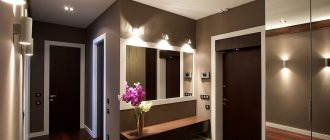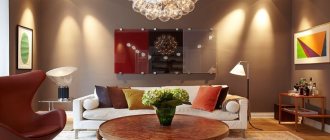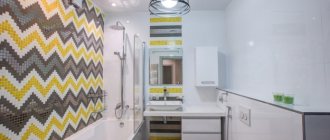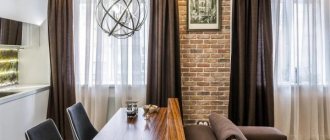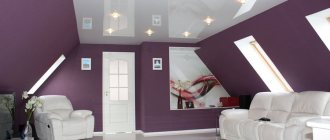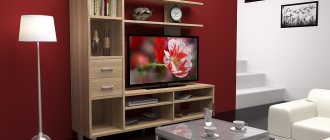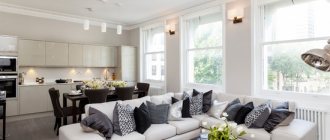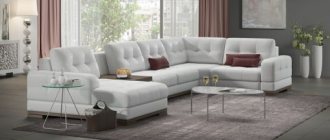Norms and requirements
In order for the light emitted in the living room to be normally perceived by the eyes of visitors, and the stay does not cause excessive visual strain, the installed lighting must comply with the requirements of SanPiN 2.2.1/2.1.1.1278-03 and SP 52.13330.2011, which determine the permissible level of illumination:
- at least 150 Lux for general lighting of the living room;
- not less than 300 Lux for places of increased visual stress (a table for doing handicrafts, if you are making something or repairing something in a certain area of the hall);
- from 300 to 500 Lux when installing an office desk, where you keep documentation, work with papers, or children learn lessons;
- To organize decorative lighting, 20 - 30 lux will be enough.
In addition, to comply with basic safety requirements, the following standards must be met:
- The key switch for switching the living room lighting must be located at a height of 0.8 to 1.7 m in accordance with clause 6.6.31 of the PUE.
- Please note that in accordance with clause 7.1.51 of the PUE, the key switch must be installed at the entrance from the door handle.
- Based on clause 1.7.51 of the PUE, the metal housing of lighting fixtures must be connected to protective grounding in order to protect a person in the event of a violation of the lamp insulation.
- Lighting devices in accordance with clause 2.1.21 of the PUE must be connected to the internal electrical network via terminals, soldering or crimping; connecting them by twisting is strictly prohibited.
When choosing a place to install artificial lighting devices, it is important to consider the appropriateness of a particular position in relation to cabinets, a sofa, a TV and a free passage area. In any case, they should not interfere with your ability to move freely, open doors or perform other daily tasks. If the furniture is not yet in the living room, then after the work is completed, cabinets, shelves and other attributes should not block the path to the distribution of light flux.
Selecting a luminaire type
The modern market provides a fairly large selection of lighting devices installed in the living room. However, they all have a number of significant differences, which are important to consider when designing lighting design.
Within the living room, the following types should be distinguished:
- Ceiling lamp - provides general lighting in the living room, performed by a central chandelier, which must be selected in accordance with the interior design.
Ceiling lamp
- Spotlights - mounted on any surface, they are chosen for both general and local lighting, creating decorative lighting effects.
- Wall sconces - used for installation near a sofa, armchair or desk to provide local enhancement of light flux or create an independent light source that can be turned on after everyone else has gone to bed.
- Floor lamps are used as decorative decorations in large living rooms; they are also installed near an armchair or sofa to create a place for reading or handicrafts.
- Table lamps - located on work tables or sofa shelves, on bedside tables, used to locally enhance lighting. Selected in combination with floor lamps when installing both types of equipment.
- LED strips - mounted on any surface, furniture, ceiling, floor, etc. Can be used for both main and decorative LED lighting.
In addition to this distribution by type of lighting fixtures in the living room, they can be organized in several ways, depending on the task at hand.
Basics of proper lighting
To organize effective lighting in the living room, it is recommended to adhere to the following rules:
- One lamp for the hall is not enough. In addition to it, additional light sources must be present. The main option for placing the main lamp is the central part of the ceiling. Auxiliary light sources can be placed anywhere, depending on the needs.
- The central area of the living room (such as a sofa and table) should be well lit.
- In the hall, the main light should be soft. This allows you to create comfort and harmonize the space. Halogen lamps are not suitable for the living room, as they produce too harsh a light. To soften the lighting, matte shades, textile or fabric lampshades are used. A cozy atmosphere is also created through lower lighting in the corners of the room.
- Do not install spotlights on the ceiling in one row. Lamps of this kind do not necessarily have to form a single ensemble.
- Properly organized lighting hides the defects of the room and emphasizes its advantages.
- If the living room has low ceilings, a hanging chandelier is the wrong solution. It is better to choose compact lampshades pressed to the ceiling or spotlights.
- For some lamp models, you will have to lower the ceiling slightly, which will allow you to disguise the wiring. In order not to reduce the height, you can purchase built-in devices.
- In elongated living rooms, you should not place the only chandelier in the center. It is better to install several lamps, evenly distributing them throughout the room. There should be no dark corners in the room. Moreover, good illumination must be achieved through the main light. Additional sources are designed to perform only special tasks (for example, local reading lighting or bar lighting).
- If the room has suspended ceilings, they can be equipped with a section of lamps with adjustable glow intensity.
- A fireplace (bio- or wood-burning) can act not only as a decorative element, but also as a lighting device.
Living room lighting options
Despite the fact that just a few decades ago, for the majority of the population, the issue of lighting in the living room was solved by one pendant lamp, with the development of the industry, the population’s needs for expanding the spectrum have also grown significantly. Today it is not enough to install a central chandelier and be content with natural light from the window, so we will consider each type of lighting separately.
General light
This type is designed to create uniform lighting throughout the entire living room with sufficient visibility in every corner of the room. For its implementation, ceiling chandeliers, spotlights, and high-power LED strips are appropriate.
If the living room has a small area - about 15 m2, then it can be illuminated with one chandelier in the center of the room.
However, pay attention to the height of the ceilings:
- if the height is 3 m or more, then the chandelier is selected on a suspension, otherwise the flow of lighting will be lost under the ceiling;
- at a height of about 2.5 m, you should use ceiling-mounted models that will redistribute the light throughout the room;
- at a height of about 2 m, a model with several shades directed in different directions is used, but even here the central chandelier may not cope.
In large rooms - from 25 m2 or more or with a low ceiling of 2 m and below, one chandelier will not provide good illumination around the perimeter, so in such situations you can mount spotlights along the entire ceiling surface or install several chandeliers in different parts of the room.
Combinations of a central lighting fixture in the living room and several spot spots around the perimeter or an LED strip work quite well. Such a combination will enhance the lighting, and different lamps can perfectly complement each other in the design of the living room.
Local
Floor lamps, wall lamps, spots, spotlights, lamps, etc. can be used as local sources. The main task of local lighting is to organize a certain area near an armchair, sofa or table, but even here there are a number of nuances in arrangement. Be sure to plan the location of local lighting in relation to interior items.
The sconces should be placed near the sofa or armchair at a height of about 1.2 - 1.6 m from the floor level; lamps arranged in pairs look quite beautiful. However, if there is a TV opposite, it is better to install wall lighting fixtures half a meter away from the plane of the screen. Otherwise, glare can ruin your viewing of any TV show.
It is better to move floor lamps to the corner of the room, this will create an interesting effect when the central chandelier is turned off. The lighting will move to the periphery of the living room and become more subdued.
Decorative
The main purpose of decorative lighting is to decorate the interior of the living room. Thanks to well-designed lighting effects, you can significantly improve even an empty room, create a more harmonious interior, or add some zest. The main thing is not to overdo it with lighting, otherwise the room and all the furniture will simply get lost in the variety of lighting.
This lighting option can be organized using LED strips or low-power LED lamps, duralight or flexible neon.
Depending on the installation location, decorative lighting in the living room can be used for:
- ceiling niches and ceiling perimeter;
- shelves or niches in the wall;
- contour of the floor plinth;
- the contour of a doorway, window sill;
- furniture in the hall;
- paintings, photos, aquarium or thematic imitations.
Depending on the color characteristics, you can use single-color backlights, or you can install multi-color RGB-based strips.
Spot
This type of lighting in the living room is used where you want to emphasize a certain area of the room or any piece of furniture: a picture on the wall, a vase, decor, etc. Spotlights, spotlights or round lamps with directional flow can be used as spot options.
They not only highlight certain areas well, but can also be used to complement or fully equip general lighting. In the modern design of suspended and suspended ceilings, they are used to create various light figures on the ceiling canvas.
Intellectual
When installing multi-level lighting or having quite a large number of lighting fixtures in the living room, managing all this diversity can cause serious difficulties. Therefore, to control a large number of devices, intelligent lighting is used, where each lamp or group of them is switched, switched or switched to another mode using a control panel.
Stylish lighting
The choice of what its lighting will be depends on the style of the living room: ceiling, floor or wall. Lighting fixtures should be in perfect harmony with the overall interior. Don’t forget about this, relying only on your desires and finances.
For a loft living room, the best option would be lamps suspended on chains or wires, adjustable in length. They are mainly installed in sofa or dining areas. For a Provence living room, natural elements are considered ideal: wood, metal, ceramics.
Light zoning
The principles of zoning in the living room provide for the need to highlight any object that you would like to emphasize in the overall interior of the room. This could be a coffee or coffee table, an armchair, a chair, shelves near the TV, etc. Thus, objects or entire areas in functional areas will be better illuminated, and the surrounding space with all its contents will be darkened. This technique will help you place accents at the right points, but they will have to be foreseen at the design stage.
Peculiarities
In cases where, according to the designer's idea, the room is illuminated using a chandelier, spotlights or diode strip, one or more switches can be used.
The latter option allows you to play with the atmosphere in the living room and turn on certain types of lighting.
Experts recommend purchasing living room ceiling lighting with diffused light. And if the coating is an even white color, it is recommended to illuminate not only the room, but also the ceiling.
This technique will help to visually expand the space and distribute light evenly throughout the room.
Lighting in the living room with suspended ceilings
According to its texture, a stretch ceiling can have a matte, glossy or satin surface, which will significantly affect its ability to reflect light. Therefore, for glossy ones, you can install pendant lamps with an upward flow; the light will still be reflected from the film and create soft, uniform lighting in the living room. Matte ones reflect light to a lesser extent, but a sufficiently powerful lamp can solve this problem.
Suspended, built-in, and ceiling-mounted lamp models are equally suitable for installation in suspended ceilings. However, please note that the lampshade close to the film should never heat up, otherwise the film will be deformed and tear. Therefore, it is better to avoid incandescent lamps or powerful halogen lamps.
A stretch ceiling can be effectively illuminated from the inside, providing a beautiful effect. Or install lighting in a plasterboard niche around the perimeter, under the ceiling plinth or in a box. If the living room has multi-level ceilings, the lighting of the niches can be arranged separately.
Important nuances
General recommendations for organizing light will make your task much easier. The main nuances in choosing lighting sources include:
- functionality of the equipped premises;
- the presence and volume of natural light, the location of window openings;
- general design style;
- use of additional interior accessories.
When arranging bedroom lighting, you must remember that the atmosphere in it should be conducive to rest and sleep, so it is recommended to use light that is slightly dim and not irritating to the eye. Safety and convenience are important for children, both during play and learning. For the living room - the ability to adjust the brightness of the lighting.
Modern lighting in the living room is primarily based on performing several functions at the same time. This is a place where you can have a get-together with the whole family, watch TV, gather around a common round table, meet guests, or just relax in your favorite cozy chair.
It is very important not to oversaturate the interior with lighting fixtures and arrange them correctly without violating the integrity of the interior design. For example, in the living room there may be several lighting sources, because an ordinary chandelier is not enough, or it can be replaced with point light sources.
To zone the space, it is recommended to use various lamps. For example, original floor lamps, designer lamps or stylish sconces.
Where should switches and sockets be located?
Switches in the living room should be installed at the entrance so that you can turn on the lights before you cross the threshold. If you are planning several lighting groups, then no more than 4 switches are recommended in one place, otherwise you will get confused in them. For ease of use, the central lamp can be powered from a pass-through switch, the first key of which will be at the entrance, and the other, near the sofa, this will allow you to turn off the living room lighting without getting up from the upholstered furniture.
Switches for local lighting - sconces, floor lamps or table lamps should be placed in close proximity to the corresponding equipment. Sockets for connecting them are also installed in close proximity. In addition, it is recommended to make at least one outlet in the corner of the room, for air conditioning, TV and other devices that you plan to install in the living room.
General light
This type of lighting consists of fixtures that distribute light throughout the room. For this purpose, one or more lighting fixtures of various types can be used, installed or built into the ceiling.
Note!
Tulle design for the living room: tips on choosing fabric materials, colors, types of tulle. Decor and accessories for tulle in the living room (photo + video)Living room design - current ideas and the best interior design combinations. Tips for choosing furniture styles and models
Partition in the living room - 180 photos and video master class on how to correctly install different types of partitions
References
- E. Henderson, A. Borsiks “Style. Thousands of tricks and tricks for decorating any interior" 2017
- G.M. Knorring, I.M. Fadin, V.N. Sidorov “Reference book for the design of electric lighting” 2010
- S. Masterova “Apartment Ergonomics”
- Dorothy Wood, Decorating Your Home. Practical encyclopedia" 2004
- G.M. Knorring, I.M. Fadin, V.N. Sidorov “Reference book for the design of electric lighting” 2010
- M.Yu. Chernichkin “All about electrics. Modern illustrated encyclopedia" 2016
